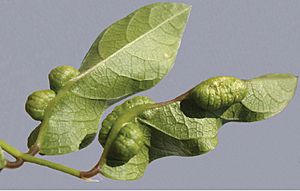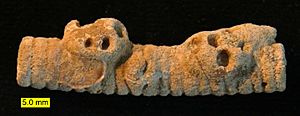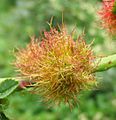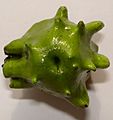Gall facts for kids
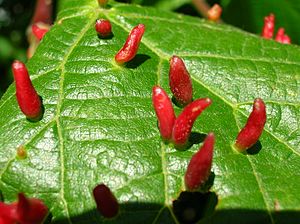
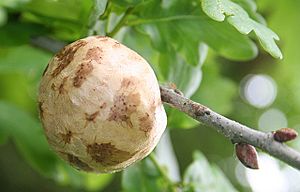
Galls are unusual bumps or growths that appear on plants. They can also be found on other living things, like some animals. These growths are caused by tiny invaders, often called parasites. These can be things like fungi, bacteria, insects, or tiny mites.
Plant galls are like small, harmless tumors or warts on plants. They are made of plant tissue that has grown in an abnormal way.
What Are Galls?
You can often tell what caused a plant gall just by looking at its shape. Many galls have a special look that helps scientists identify the creature that made it. This is especially true for galls made by insects and mites.
How Insects Use Galls
Insect galls give certain plant-eating insects a special home. The insect actually controls how the plant tissue grows to create this home. The gall becomes a safe place for the insect to live and find food.
Galls can be full of healthy starch and other good things for the insect to eat. They also offer a lot of physical protection from animals that might want to eat the insect. It's like a tiny, custom-built fort!
How Galls Form
Insect galls usually start when an adult insect or its young (larva) injects special chemicals into a plant. Sometimes, just the insect moving around on the plant can also help start a gall.
Once the gall starts to form, the young insects grow inside it. They stay there until they are fully grown and ready to leave. For galls to form, the insects need to act when the plant cells are dividing and growing quickly. This usually happens during the plant's main growing season, like spring in places with different seasons. In warmer places, the growing season is longer.
Gallery
-
Gall on a Maple leaf
-
Eucalyptus leaf gall
-
Oak marble galls, one with a Gall fly exit hole and another with Phoma gallorum fungal attack.
Images for kids
-
A crown gall on Kalanchoe infected with Agrobacterium tumefaciens.
-
Goldenrod round gall made by the fly Eurosta solidaginis
-
Galls caused by an Eriophyid mite (Eriophyidae) on Banksia integrifolia infructescence in Melbourne, Australia
-
An oak tree with multiple oak apples
-
Eucalyptus cypellocarpa at The Gap Scenic Reserve, Australia
-
Gall attack on Eucalyptus due to Leptocybe invasa at Acharya N. G. Ranga Agricultural University
-
Fruit gall on Actinidia polygama
See also
 In Spanish: Agalla para niños
In Spanish: Agalla para niños


